
For those who have little knowledge of karate will likely think of a whole series of what the discipline is about, none of which necessarily pertain to yoga. From the outside looking in these two worlds couldn’t be further apart: a combative practice versus a practice intended to cultivate non-violence. Is it possible that karate could be reinforced with the yogic values such as ahiṁsā, or non-violence, along with mindfulness and respect for oneself and others?
Yogini and Karateka Beate Troger has practiced the discipline for several years and over time has discovered more and more similarities between her two passions. The most convincing being the realization that ahiṁsā is where these two worlds meet.
A yoga teacher as a karateka?
The reactions that come from people in the yoga world when I share with them that I practice karate are often disapproving and vary from astonishment, looks of utter shock, silence, taking a step back, changing the subject altogether, and may even spark very emotional discussions about violence and ahiṁsā. Despite comments of criticism, I am also confronted time and time again with really interesting inquiries which attempt to understand the 'why' behind it all. In a nutshell, I see the two activities as complimentary as opposed to being separate from one another.
And why is that? My knee jerk reaction to that question is simply that yoga and karate have much more in common than one might think. My first karate lesson could be compared with a yogis first experience with the Ashtanga yoga practice.
Inner calm above speed, precision or physique
The phrase "heian yondan“ echoed through the karate classroom. Immediately following that call I saw precise body control, full concentration, indescribable muscular strength and sharp, clear movements. "I can do that, too!", was all I thought. Two weeks later, I was practicing the same kata, or fixed combat sequence that I had previously watched my fellow mates executing on that day. After a short time, however, I became overwhelmed. I didn't know what to do with my hands or feet anymore. Japanese concepts were being tossed about the room, my brain was starting to overload and I started to sweat profusely and curse to myself. Nevertheless, I felt absolutely refreshed, full of mental clarity and relaxed to a point that I seldom had felt before.
Today, I can explain this phenomenon through the words of the Yoga Sutra: yogaś-citta-vr̥tti-nirodhaḥ (YS I.2). The whole experience of complete calm after a yoga or karate session is really the most outward commonality among the two practices. Equally, the two disciplines demand a certain level of motivation and willingness to engage in something that is completely alien, with very foreign concepts and sequences. If you can manage to work through this without giving up, you are truly rewarded with the results of your practice. I am very lucky to have had the chance to reap the benefits from these two different disciplines.
Split Roots: The history of karate
The parallels between yoga and karate go far beyond the calm following the physical practice. While the practice of karate that we know today is shaped through its development through Buddhism and the Japanese culture of the island of Okinawa, it actually has its roots in India. According to the tradition, monks in India carefully observed the battles of different animals and derived from this inquiry a series of combat techniques which did not require weapons.
These techniques can still be found today in the Indian martial art form called kalarippayattu, which is regarded as the oldest systematic martial art form in the world. Interestingly, quite a lot of yogic thought from the Yoga Sūtra and the Upaniṣad have influenced kalarippayattu, as well as the right knowledge of Ayurveda particularly the nāḍis and the very sensitive marma-points.
In the 3rd century BC, as Buddhism began to flourish on the Indian subcontinent, primitive martial art forms traveled northeast. The Indian monk Bodhidharma traveled along the Silk Road across the Himalaya to the Shaolin Monastery in Henan, which is still famous even today. He shared the physical and spiritual techniques of kalarippayattu with the monks there who were translating the Yoga Sutra and Buddhist texts into Chinese.
Numerous wars and conflicts over the following centuries in ancient China led to the monastery being destroyed and the monks fleeing for refuge. Due to this, many of the ancient texts which included instruction of the knowledge of martial arts such as karate, taekwondo and kung fu were destroyed. As a result, our knowledge of these disciplines remains incomplete.
Modern karate emerged as an offshoot from the original martial art. It was refined, systematized and further developed in Okinawa into the practice which is known today.
Martial art with a strong philosophical foundation
Karate can be translated as "the path of the empty hand". The Japanese character, which stands for the syllable "kara", or empty, is related to "satori" from Zen Buddhism, which means "a state of detachment from all things of the sense or intellectual realms". It is another word for enlightenment. In yoga, we call this state samādhi.
Gichin Funakoshi (1868 – 1957) played a major role in the development of Shōtōkan-Karate in the 20th century. Funakoshi wrote a number of basic works on the subject, including a book describing the foundations of karate philosophy, known as the 20 Shōtō-Niju-Kun. In these 20 verses he describes what karate is really about. He places great emphasis on the spiritual and philosophical aspects of the practice, and points out that these should shape the way one trains and thus the martial art is ultimately developed to guide a person on their personal life journey.
Here we see even further examples of the parallels between yoga and karate. The term "satori" itself proves that the very basis of both disciplines are one and the same.
Shōtō-Niju-Kun and the Yoga Sūtra
Two foundational texts of karate and yoga describe this similar path quite clearly. Funakoshi writes in verse 1: "The path of karate begins and ends with respect“. Rei (Japanese for respect) contains what differentiates sheer violence from a martial art. Rei brings the aspect of ahiṁsā to karate: ahiṁsā means non-violence – and thus karate to me is synonymous with ahiṁsā. This means that pure violence cannot exist in the realm of training in and application of martial arts. "One who thinks only of themselves, who is tactless is incapable of learning karate-dô“, wrote Funakoshi in his autobiography.
To my mind, the goal of karate-dô, just as in yoga, is to make one aware of their own inner struggles. This means on one hand to recognize where I may be sabotaging myself in my own thoughts or uprooting beliefs deeply set in avidyā, and on the other hand to take part in a peaceful struggle to eventually defeat my own ego one day.
The motive of non-violence continues into the following verses of Shōtō-Niju-Kun. The second verse states: "In karate there is no first attack“. Confrontation should be absolutely avoided, so yet another reference to ahiṁsā. Instead, according to Funakoshi, the qualities of patience, forbearance and loving-kindness should be cultivated and nurtured and be considered the supreme goal. These are the same qualities mentioned in the Yoga Sūtra (I.33) where the four bhavanas are listed. Funakoshi himself stood behind these rigorous basic rules of karate, forbidding his students from engaging in superficial competitions, or to use the body as a weapon in daily life. Regardless of the situation, any student would be immediately expelled if they were found involved in a fight.
Ultimately karate is mainly about mindfulness and our approach with ourselves and others – demonstrating yet another direct similarity to the practice of yoga. We practice yoga to cultivate mindfulness. We breathe and move consciously and respect our limits. In karate we are also constantly reminded of how really aware and mindful we have to be, in that the application of these techniques can be extreme and deadly.
The physical practice: similarities and differences
In karate, each exercise begins and ends with a short group meditation in order to center and bring the focus inwards. Generally, there is a warm-up phase with dynamic and static exercises coming from gymnastics, yoga, calisthenics and are followed with some coordination movements. After that, the basic techniques of karate, know as kihon, are practiced. The term is composed of two parts: "ki" which mean energy and is known as "prana" in yoga and Ayurveda and with the Chinese terms Chi or Qi, and "hon" which means basis or foundation.
Another element of Shōtōkan-Karate-dô is kata, a precise, pre-defined sequence of block and attack techniques, as well as combinations against an imaginary opponent.In this form it is not only the techniques wich are learned, but also timing, rhythm, coordination, proprioception and personal expression. Performing kata is regarded as an expression of the highest concentration or even a moving meditation.
I personally compare kata with sūrya namaskāra. Both systems follow a fixed sequence of movements, which I create in my body based on my physical interpretation. What am I getting out of the movements? How do they feel? How do I feel as I am doing them? How am I breathing and what does this practice mean to me? These are central questions that arise for me during practice, be it a kata or in Aṣṭāṅga Vinyasa. This is what separates these practices from any other type of sport. I feel that in both I am guided into deep concentration through mindful movement where I can feel most deeply what it is to be alive, and where I can equally dedicate myself to conscious awareness of my body, mind, life energy and emotions.
Breath-led movement, balance and dynamics
Another parallel between yoga and karate is the fact that in both disciplines breath precedes movement. Breathing is the means to connecting with energy and initiating movement, whether on the yoga mat or at the karate dôjo.
In addition, balance and finding one's center plays a central role. This is precisely the principle of kanda that we refer to in yoga, or, our center of gravity. Likewise, this is the center of the body and the seat of physical and energetic force in karate known as hara. Of course, when you look at how moves are executed, there are clear differences between the two disciplines. I am limited to my yoga mat in the yoga practice, whereas in karate I have the entire space around me at my disposal. In karate there is a clear focus on speed and repetition, which can bring your heart rate up a bit more quickly than in a yoga practice. There are then these short pauses, or kata, where it is a bit more like the breaks in interval training, and which is not found in the practice of yoga. Even moving dynamically as we do in Aṣṭāṅga Vinyasa yoga, you will barely find that your pulse range increases to an aerobic level.
"Mysore Style“ and the essence of yoga and karate
One final similarity between yoga and karate, at least for me, is the didactic approach with with the traditions are taught. In both disciplines, there is a very individual, tailor-made lesson that is passed on from teacher to student, where the student learns from their teacher over decades. "Yoga is 99% practice and 1% theory," said Pattabhi Jois. The karate master, Gichin Funakoshi, expresses the same idea: "Only through continuous and repeated exercise will you succeed in reaping the fruits of the journey in spirit and body". While the words chosen may vary, the message is the same from both teachers: you have to show up and do the work.
Day after day I practice the same Aṣṭāṅga Vinyāsa series. In karate, I will likewise practice a given kata for months on end. And it never gets tired because with each session I discover new impulses and nuances of the movements. In doing so, I don't get better at yoga āsana or karate, I get better at knowing my true self.

Rolf Schüller
at 13.06.2021Hallo Beate, ganz toller Bericht mit sehr vielen interessanten Infos. Viele Grüße Rolf Hallo Beate, ganz toller Bericht mit sehr vielen interessanten Infos. Viele Grüße Rolf

Andrea Montrasio
at 01.05.2018Hallo Beate,
mit großer Aufmerksamkeit habe ich gerade deinen Artikel gelesen und es freut mich sehr , dass die Parallelen, die ich als Yoga Anfängerin aber auch als alte Karateka bemerke , hier [...]Hallo Beate,
mit großer Aufmerksamkeit habe ich gerade deinen Artikel gelesen und es freut mich sehr , dass die Parallelen, die ich als Yoga Anfängerin aber auch als alte Karateka bemerke , hier Eingang gefunden haben . Gleiches ist mir auch beim Üben von Qi Gong aufgefallen und ich merke wie alles absichtlich und unabsichtlich in mein Karate Training einfließt .
Ich würde mich sehr freuen wenn wir mal einen Austausch „ vor Ort „ bei uns im Dojo ( PSV Heidelberg ) oder an einem anderen Ort haben könnten . Schreib mir doch einfach mal ! Ich wohne auf dem Dilsberg ,kurz vor Heidelberg , vielleicht können wir da was Gutes beginnen ! Davon abgesehen interessieren Dich vielleicht auch meine 200 Kochbücher ..Hallo Andrea,
freut mich sehr, wenn der Artikel so gut ankam! Bzw. scheinen sich da eventuell ja spannende Projekte zu ergeben... Haltet mich gerne auf dem Laufenden wie es weiter geht - wer weiß, [...]Hallo Andrea,
freut mich sehr, wenn der Artikel so gut ankam! Bzw. scheinen sich da eventuell ja spannende Projekte zu ergeben... Haltet mich gerne auf dem Laufenden wie es weiter geht - wer weiß, vielleicht ergibt sich ja ein "follow up" :-)
Namaste und liebe Grüße
Sabine
Beverly Hills Beverly Hills
at 29.03.2018Sehr gut geschriebener Artikel. Ich hätte nie gedacht, dass es so viele Parallelen zwischen Yoga und Karate gibt. :) Sehr gut geschriebener Artikel. Ich hätte nie gedacht, dass es so viele Parallelen zwischen Yoga und Karate gibt. :)
Freut mich sehr, dass Dir der Artikel gefällt. Und schon einmal eine kleine "sneak preview" - das war nicht der letzte Text über Yoga und die Parallelen zu anderen Sportarten :-) Stay tuned :-) Freut mich sehr, dass Dir der Artikel gefällt. Und schon einmal eine kleine "sneak preview" - das war nicht der letzte Text über Yoga und die Parallelen zu anderen Sportarten :-) Stay tuned :-)

Ralf Herbst
at 04.10.2017Vielen Dank für diesen Artikel.
Die Parallelen zwischen Yoga und Karate sind mir als Übender gerade in den letzten zwei Jahren ebenfalls sehr bewußt geworden. Fußstellungen wie Zenkutsu Dachi im [...]Vielen Dank für diesen Artikel.
Die Parallelen zwischen Yoga und Karate sind mir als Übender gerade in den letzten zwei Jahren ebenfalls sehr bewußt geworden. Fußstellungen wie Zenkutsu Dachi im Krieger 1, Yoga mit kleinen Abwandlungen als Aufwärm-Übungen im Karate sowie die Bedeutung des Atmens und der Meditation deuten m.E. auf gemeinsame Wurzeln hin. Zudem die Ähnlichkeiten zwischen Kata und den festgelegten Serien speziell im Ashantga, die Sie auch betonen. Meines Erachtens kann man Yoga und Karate mit großem Gewinn parallel betreiben.Vielen Dank für das Feedback! Ich war selbst überrascht zu hören, dass es offensichtlich doch eine ganze Reihe von Yogis gibt, die beide Disziplinen sehr gewinnbringend parallel betreiben - und freue [...]Vielen Dank für das Feedback! Ich war selbst überrascht zu hören, dass es offensichtlich doch eine ganze Reihe von Yogis gibt, die beide Disziplinen sehr gewinnbringend parallel betreiben - und freue mich als Chefredakteurin natürlich sehr über sämtliche Rückmeldungen/Erfahrungen zu diesem Thema!

Janine Boothroyd
at 10.09.2017I totally agree with your opinion regarding the parallels between Karate and yoga. I have been a Karateka for 17 years and practiced yoga on a less regular basis for more than 10 years. The [...]I totally agree with your opinion regarding the parallels between Karate and yoga. I have been a Karateka for 17 years and practiced yoga on a less regular basis for more than 10 years. The spiritual/mind side of both practices are very complementary. The original thing that drew me to karate was the complete focus required and the way you felt completely de-stressed by the practice.
i have only recently been practicing ashtanga yoga and find i really like it and have felt immediately that it has parallels to karate kata.
The breathing focus also has many similarities.
Thanks for your great article as it is refreshing to hear that others have found the same experience.Thank you so much for sharing these experiences! Exciting to read that also others feel that there is a parallel between Ashtanga and Karate... Have fun practicing! ;-) Thank you so much for sharing these experiences! Exciting to read that also others feel that there is a parallel between Ashtanga and Karate... Have fun practicing! ;-)
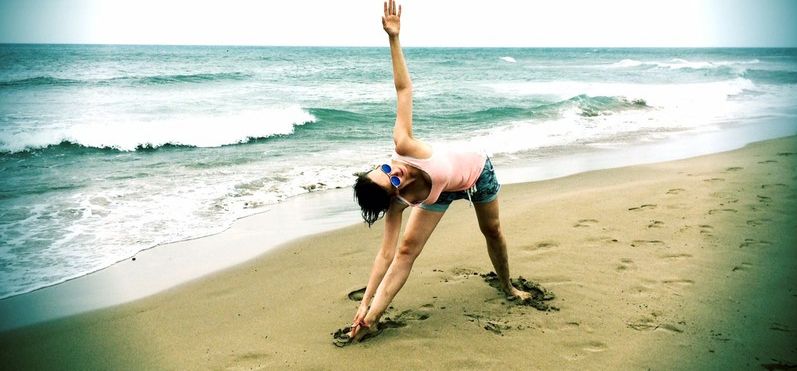

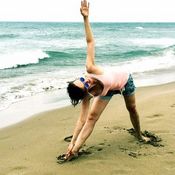
 Beate Troger
Beate Troger
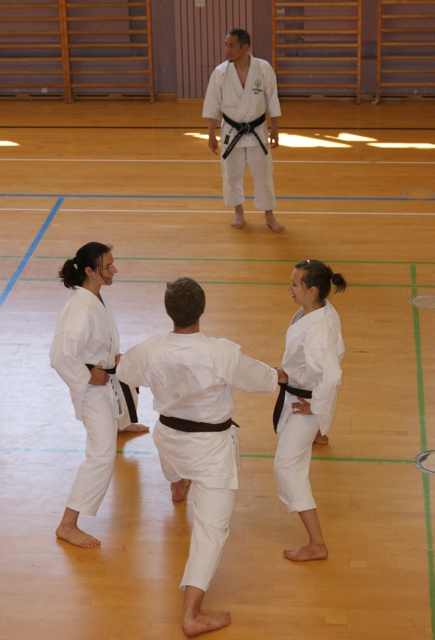
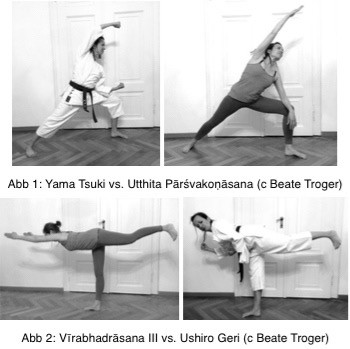
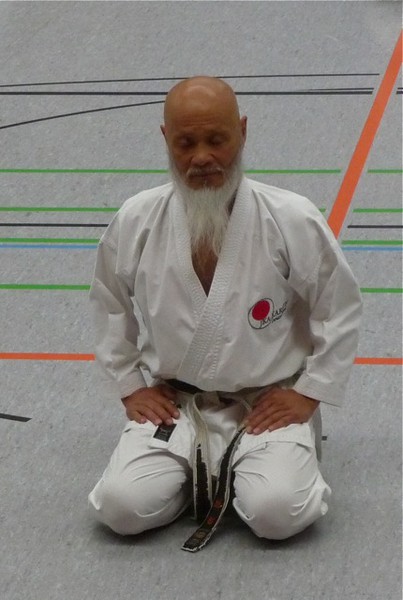
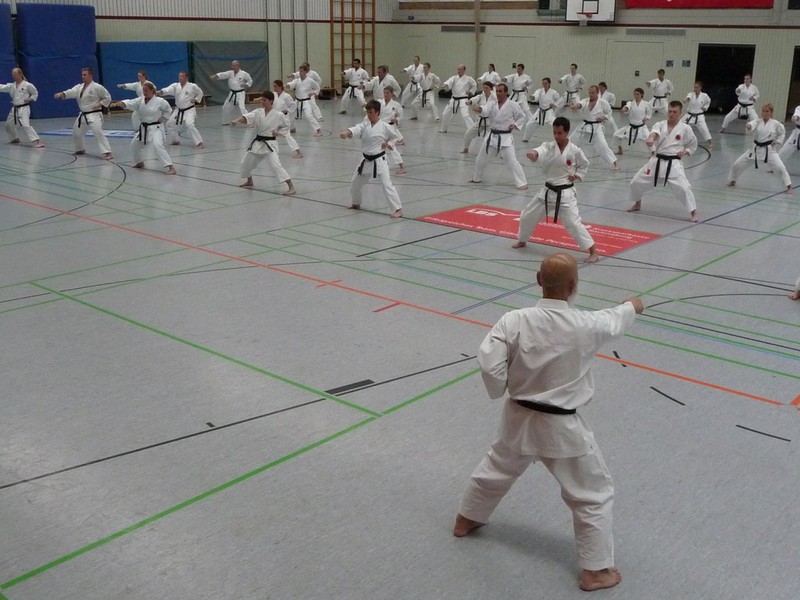

Messages and ratings